Interfaith Chapel at University of Rochester
How the Interfaith Chapel at the University of Rochester has acted as an inclusive space of beauty for all beliefs
by Chris Clemens
Most every place we’ve visited on this blog have been a space or site dedicated to a single faith. There have been places that house more than one religious group, but still, it’s one group renting space from another. The two groups are very friendly and even engage one another regularly, but still isn’t considered ‘interfaith’.
The UUA with its wide open membership might be close, but that’s a little different. With them, its just different individuals meeting together as UUAs.
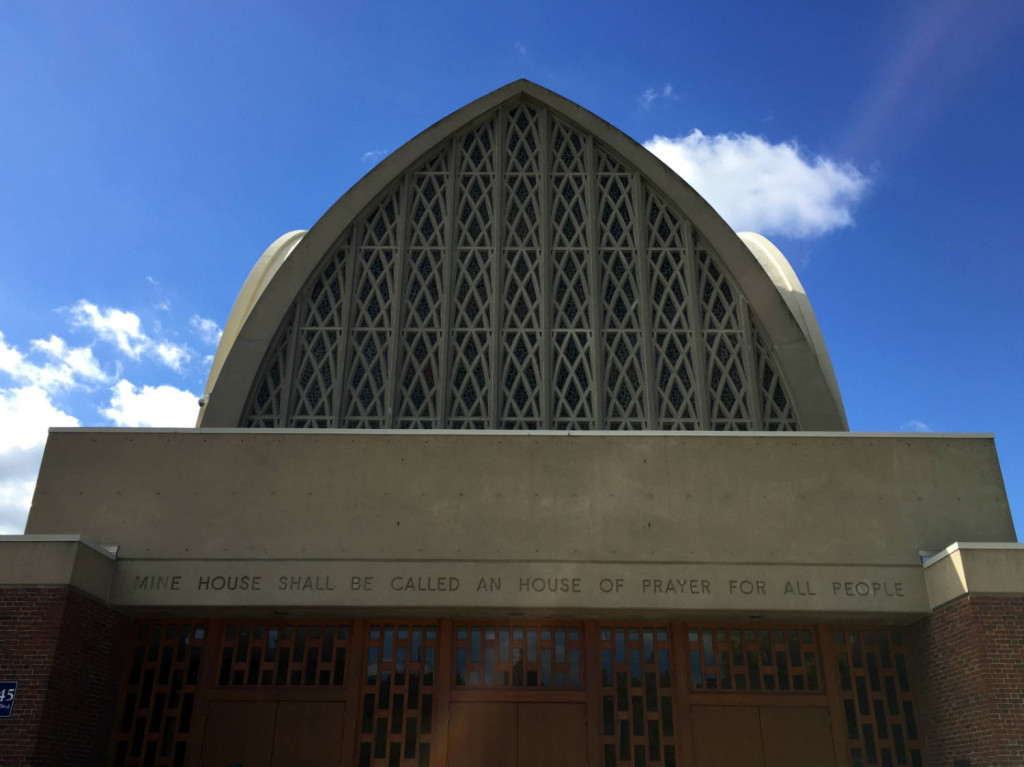
Chapels, Explained
The term ‘chapel’ is typically aligned with interfaith worship. Historically, it was just anyplace that the church may have owned that they dedicated to worship. In some cases there were even individuals who owned chapels.
The earliest chapels aren’t classified as churches because they aren’t standalone facilities. Rather, they were usually a chamber or room part of a larger structure (ie. synagogue, church, Naval ship, hospital).
Most of the interfaith chapels that you’ll find today will be college campuses, hospitals, airports, military bases, and retirement communities. These are places where many different people from different walks of life reside temporarily. Some interfaith chapels are humble, and some feature grand designs. The University of Rochester chapel is amazing in photos, but I was yet to see it in person.
I reached out to the Rev. Dr. C. Denise Yarbrough, Director of Religious and Spiritual Life at the University of Rochester, and set up a time to visit.
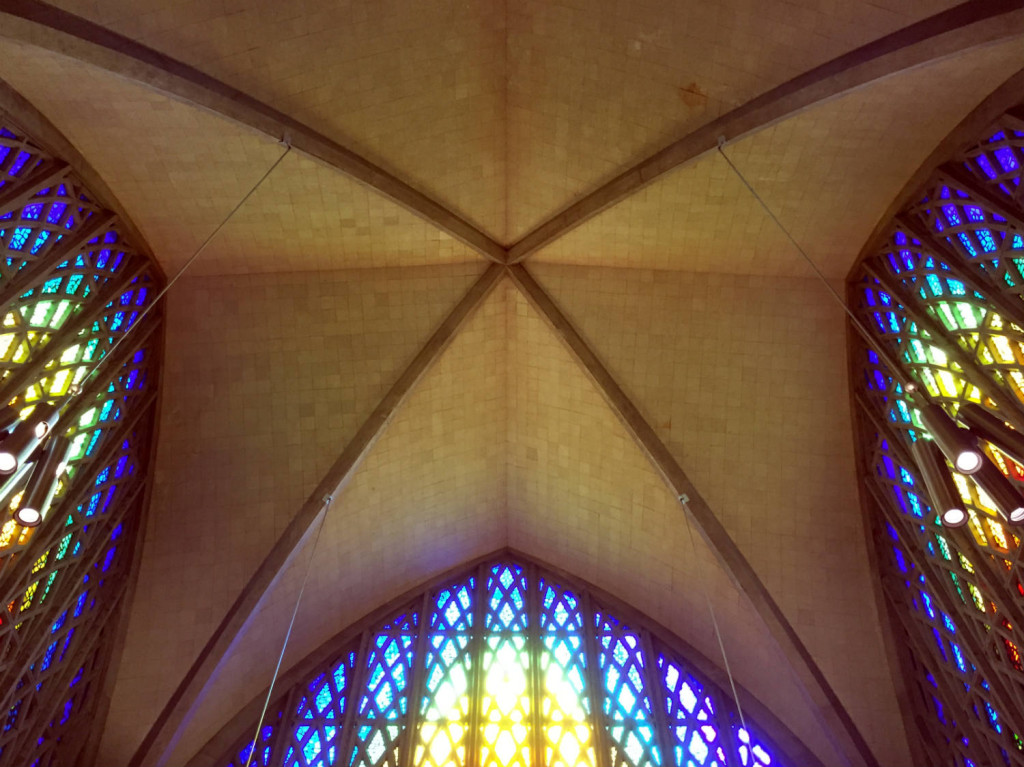
Director of Spiritual Life
Hailing from Teaneck, NJ, she received a Bachelor’s degree from Barnard College. Later, she got a juris doctor from the University of Michigan Law School, and earned Masters and Doctoral degrees from Princeton Theological Seminary. Reverend Dr. Throughout most of her life, Yarbrough has been an important part of local interfaith work.
In 2004, she became the canon for interfaith dialogue at Rochester’s Episcopal Diocese. She was (actually still is for a short time) faculty and a director at the Colgate Divinity School. Much of her focus there was also on interfaith discussion and instruction. With her background and presence in the interfaith dialogue in Rochester, she was a perfect choice for the University of Rochester to put her at the helm of guiding the Interfaith Chapel on their campus.
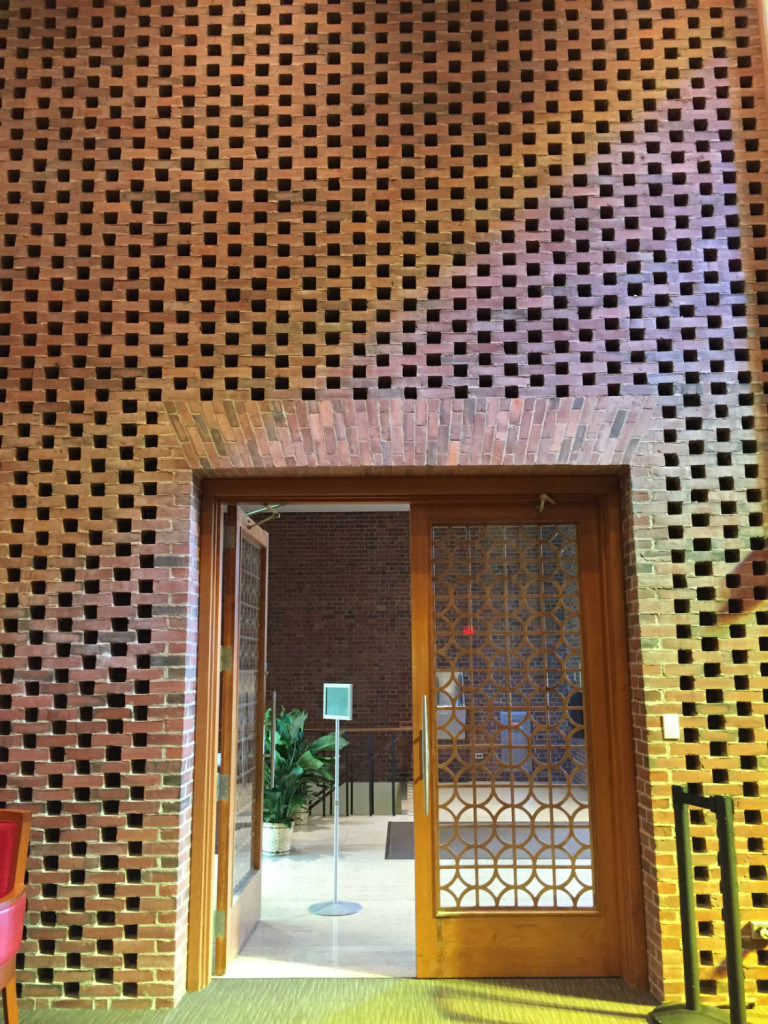
The University of Rochester was one of the first colleges in the country to have built a dedicated building as an Interfaith Chapel. They made history and completed the project in 1970. Continuing that philosophy and open dialogue is just as important to the college as it was 40 years ago.
And really, Rochester itself has really been a great place for interfaith discussion and communities. The First Universalist Church and Temple B’rith Kodesh kicked off a Thanksgiving Dinner together in 1874 and began a strong tradition in the city for interfaith celebration. It’s probably no surprise that the city and its spiritual inhabitants have continued supporting other beliefs and remained so open minded ever since.
University of Rochester’s Diverse Student Body
Admittedly, I was a bit naive about what leading the Chapel might entail–but, that’s precisely why we do this blog.
The University of Rochester has a diverse student population, so providing space for every belief on campus can get tricky. Denise could’ve easily explained that to us any day of the year, but we happened to be there during Passover. All of the normal considerations of accommodating so many different practices changes up a little with certain holidays.
The space where Muslims pray is needed by Jewish students who need a larger kitchen than they normally use. Plus, that kitchen needs to be 100% kosher for the whole week. To accommodate that, the Muslims move to another area, which doesn’t have open floor space. That means rearranging all the furniture to have enough room to pray on the floor. The Christian students normally using the space where the Muslims are get moved to another room.
Each of the large religious holidays becomes like a game of musical chairs and sharing.

The scheduling was even more than I could keep track of while we chatted.
What struck me profoundly, was how students seem to embrace the idea of sharing a worship space. It seems that it would take a very special community to embrace such constant fluctuation and change for the purposes of honoring others’ beliefs. Think about it, move something in your office that your coworkers use and see how that goes for you.
Touring The University Of Rochester Chapel
Denise walked us around all three floors of the building and showed us around.
The bottom floor is at river level, which has a beautiful view of the canal path. The path runs so close that there was concern about how Muslim students praying in the room would feel about people running or walking by looking in the windows of the room watching, so considerations were made. On the day we were visiting, it was set up for a Passover Seder and students were beginning to filter in for an evening of celebration.
It was interesting to see such a multi use looking space transformed in to a sacred one, with even an Aron Kodesh off to the side for the Torah.
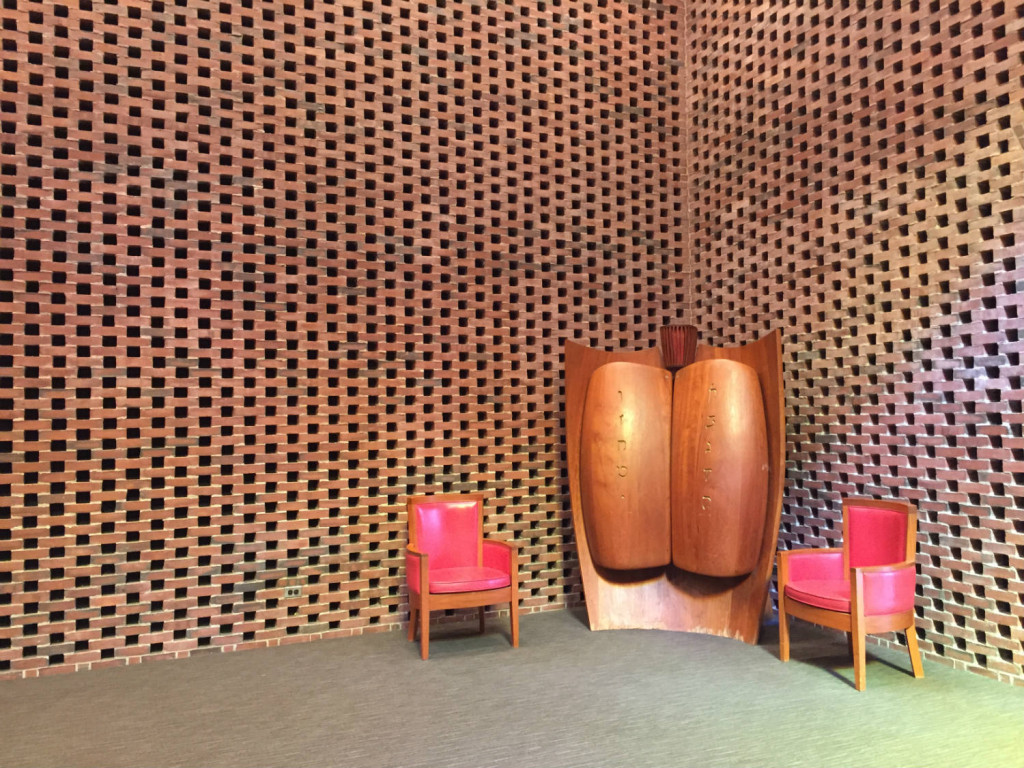
The middle floor has smaller multi use rooms and offices, but some of them are occasionally used for worship. One room was where the Muslim students prayed during the week of Passover, and later in the week it was the same room where I went to hear a local Holocaust survivor, Eva Abrams, tell her story.
Main Chapel Space
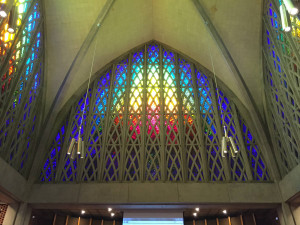
The top floor of the building houses a large sanctuary, and this is probably the space that most people are familiar with.
It’s a popular Rochester wedding locale because of its simple beauty and interfaith accommodations. So, for those Catholics who refused kicking and screaming to go through Confirmation (yours truly) and can’t be married in a church (at least, that’s the warning I received at the time of refusal), there’s still some options available that offer beauty and a strong spiritual presence.
Despite the fact that it was a cloudy Rochester day, and we were approaching sunset, the stained glass continued to wash the sanctuary with a soft, reverent light. The circular pews that intercept the sanctuary have now been replaced by chairs. On that day, it was being used by a student pianist who was practicing, which provided a fantastic opportunity to hear not only some beautiful background music while we talked, but to discover the space had great acoustics despite being square and brick. There isn’t much in the way of religious iconography, save for a beautifully carved wooden Aron Kodesh in the back corner.
It was obvious immediately why it was such a favorite spot to be married. As an aside, the space had an oddly familiar likeness to the sanctuary in Temple B’rith Kodesh.
Amen
After spending an hour or so with Denise, we certainly gained a newfound appreciation for what it means to accommodate so many different belief systems under one roof. Wouldn’t it be fantastic if all the world’s religions played together and prayed together just as well as they do at the Interfaith Chapel at the University of Rochester?
Until that happens, it’s great to know that there are a few microcosms of interfaith dialogue that exist where people go to embrace their own beliefs while honoring everyone else’s. Many thanks to Denise and the University of Rochester for having us visit!
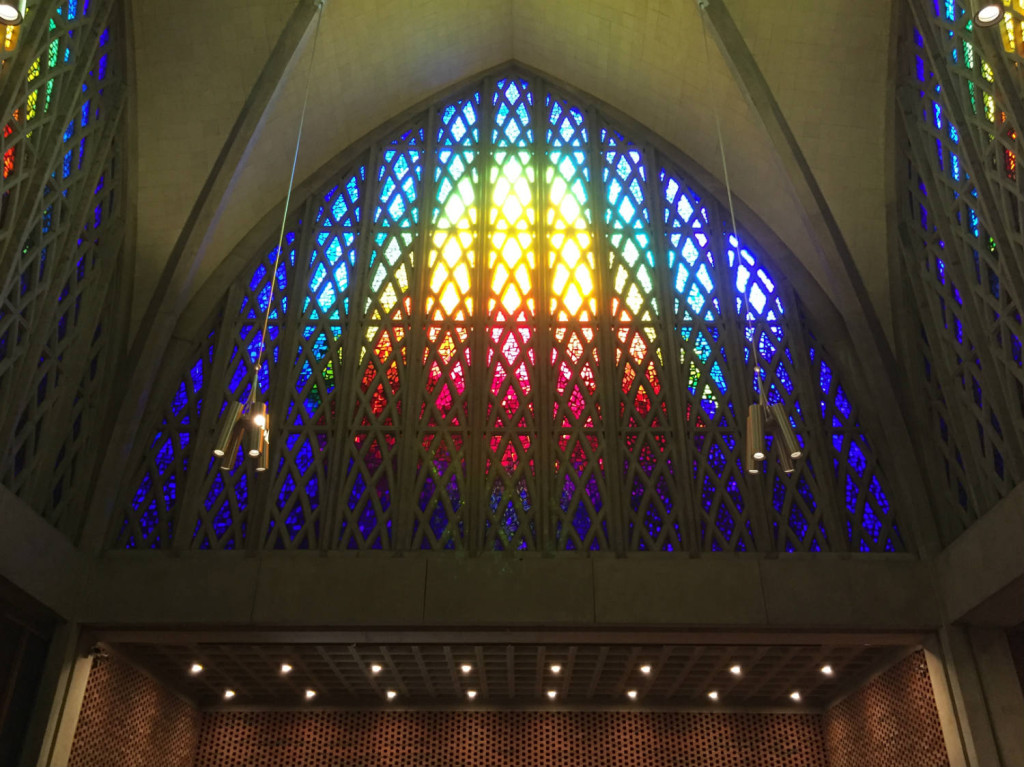
This post previously appeared on ExploringTheBurnedOverDistrict.com
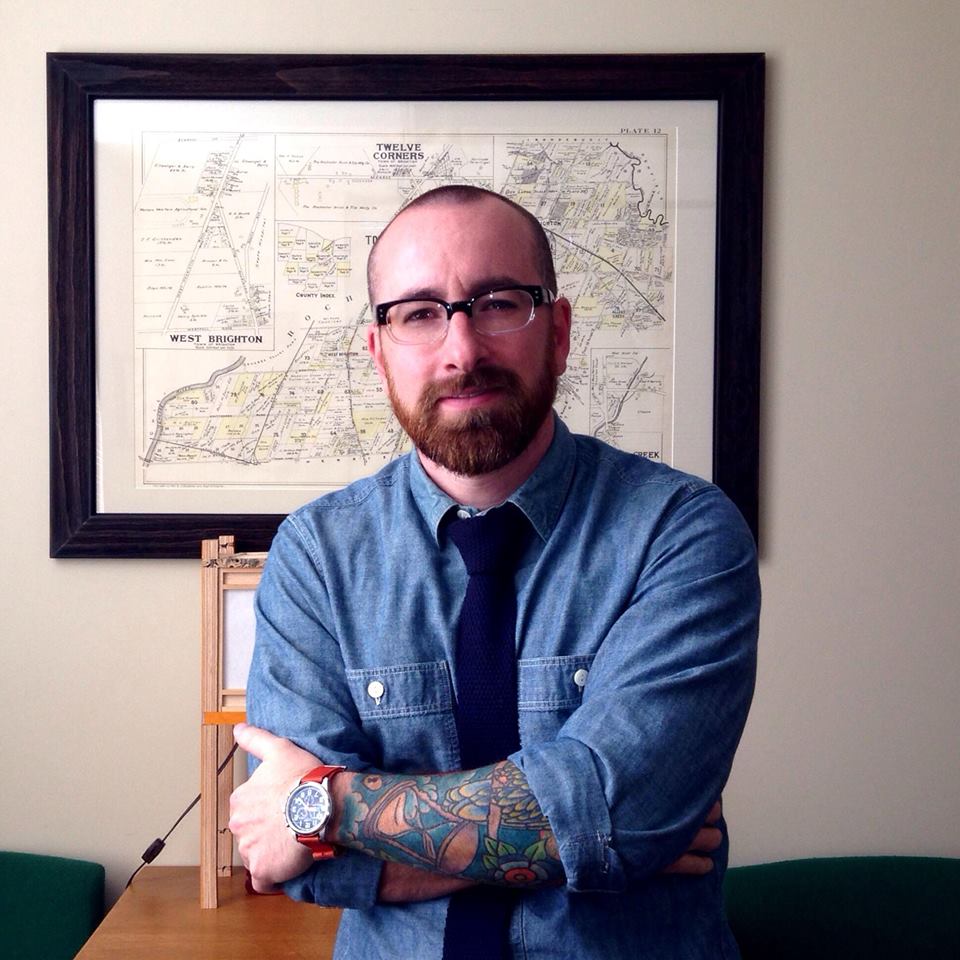
Chris Clemens is the Founder/Publisher of Exploring Upstate. From his hometown in Rochester, he spends as much time as possible connecting with the history, culture, and places that make Upstate New York a land of discovery. Follow him on Twitter at @cpclemens

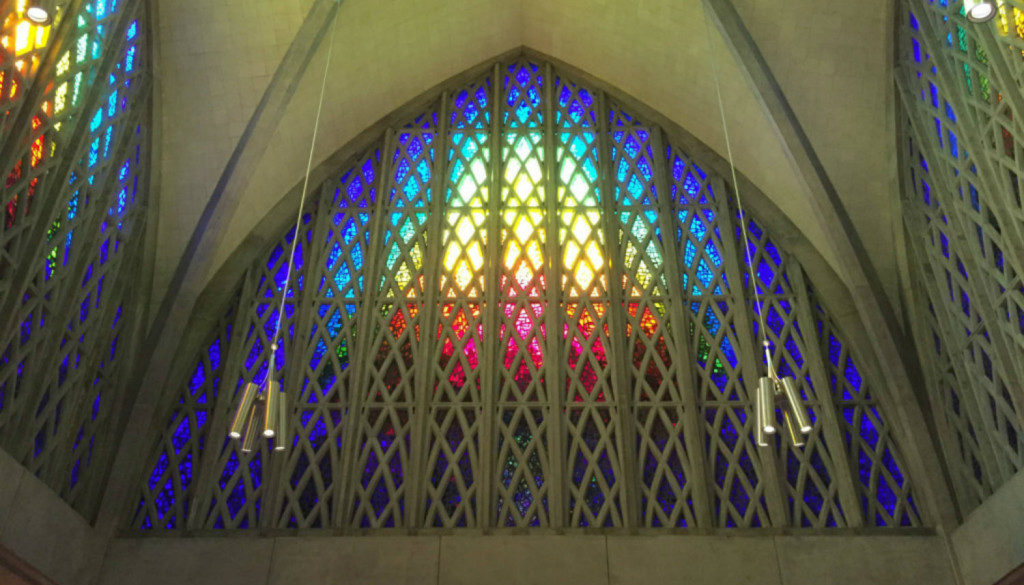

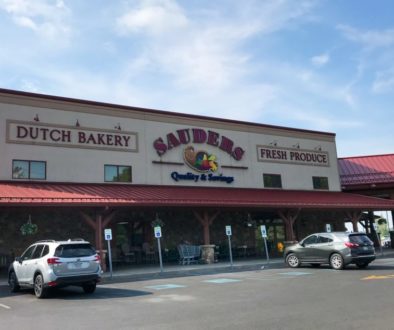
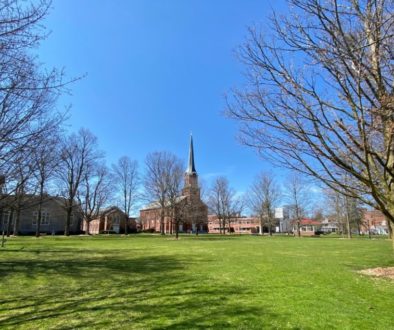
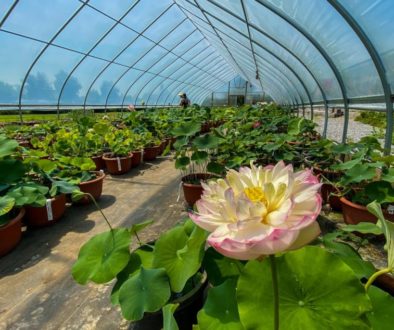
April 30, 2013 @ 10:52 am
It says a lot about the people who worship here, that they can share the space with each other peacefully. Love the windows!!
January 3, 2014 @ 11:07 am
Yeah, this sanctuary is definitely a beauty!
May 5, 2013 @ 2:47 pm
Chris and Luke,
I’m currently a grad student at the Indiana University of Pennsylvania working on my MA in history. I found your site through an image search for Shaker buildings in Watervliet and Niscayuna. I wanted to request permission to use your photo of the original meeting house in one of my seminar research papers. I’ll cite you as a source. I can easily copy the image and simply paste it into my paper, but I felt it would be good manners to ask first! Thanks for your consideration, and your blog looks like you have a great time!
May 5, 2013 @ 10:13 pm
Patrick,
We are flattered and absolutely approve! One question though, what exactly is your research paper on? It has to be something cool if you’re including something about the Shakers.
May 5, 2013 @ 11:07 pm
My paper looks at how Mother Ann Lee’s teachings, particularly gender roles and the separation of them, helped to proliferate and elongate the growth of the Shaker community. The name of the paper is “If We Don’t Have Sex, How WIll we Grow? Did Mother Ann Lee’s Teachings and the Separation of Gender Roles Help or Hinder the Growth of the Shaker Community?” That’s a mouthful…I know! I’m in a seminar class that is looking at women’s reform movements during the antebellum period in America. I grew up in KY not far from a Shaker community in Pleasant Hill and unfortunately knew little about them, so I thought I’d give Mother Ann Lee a try! Thanks so much for your help! A quick P.S. though, could you email me with your full names for the citation if it’s not too much trouble? prossteach@gmail.com.
May 9, 2013 @ 10:02 am
Actually Patrick, that paper sounds REALLY interesting. I’d love to read it when you’ve completed it! I believe Luke will be the one emailing you to follow up on this. Good luck with your research.
May 8, 2013 @ 11:12 am
There is a much older interfaith chapel: At Cornell, (“that godless university” as it was called when it was founded in 1868) Sage Chapel was built in the 1870s. Cornell also has Anabel Taylor Hall, built in the 1960s, where there is another chapel and offices for chaplains of all faiths. – Susan King, Fabius, NY, a Cornell graduate
May 9, 2013 @ 10:03 am
Susan thanks for reading and sharing that info. I’ve read about the Sage Chapel but have never been. I have a friend currently getting her doctorate there, may be time for a visit!
Interfaith Chapel; University of Rochester – Rochester, NY | Chris and Luke Explore the Burned Over District
July 9, 2013 @ 9:29 am
[…] Please visit this post on our new website found here. […]
Sri Rajarajeswari Peetam – Rush, NY » Chris & Luke Explore the Burned Over District
July 14, 2013 @ 6:22 pm
[…] place by our friend Ashok back at the Hindu Temple of Rochester, and our friend Denise over at the Interfaith Chapel at the University of Rochester, and they’ve both explained it to us as something that we would definitely enjoy. So, if […]
jotting jennifer » A Place to Say I Do
July 22, 2013 @ 8:59 am
[…] The altar and the beautiful stained glass. // Source: Chris & Luke […]
A Place to Say I Do |
February 28, 2014 @ 9:50 pm
[…] Â The altar and the beautiful stained glass / Source: Chris & Luke […]